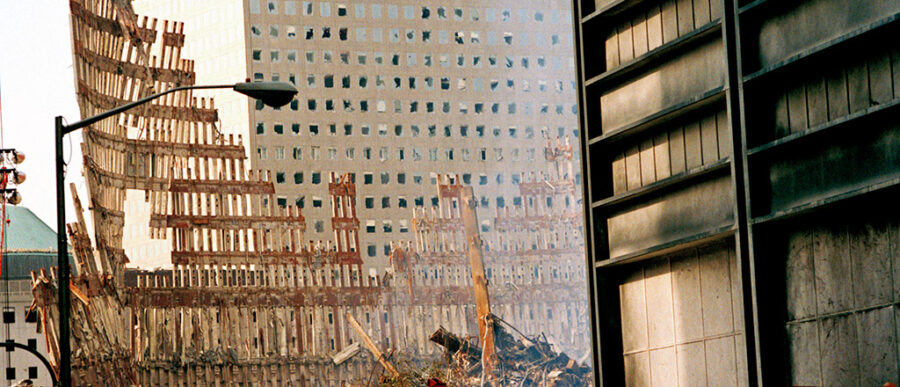The COVID-19 pandemic has pushed leaders to find new ways to manage amid evolving chaos. But the pandemic is not the first disaster of this generation to force rapid, meaningful change. The devastating terrorist attack on the World Trade Center nearly 20 years ago left behind painful memories and powerful lessons about how leaders must learn and adapt. Wharton adjunct management professor Gregory P. Shea, executive coach Andre Kotze, and retired New York City Fire Department captain Paul Brown have captured some of that insight through interviews with first responders who survived that fateful day. In the following opinion piece, they share what they have learned. Shea is also co-author of the book Leading Successful Change and a senior fellow at the Wharton Center for Leadership and Change Management.
COVID-19 disrupted organizations, scattering members to remote locations or, in the case of others such as hospital workers, packing them into prolonged and intense proximity. For weeks, more Americans died daily from the virus than died in the collapse of the twin towers on 9/11 and, in total, more than in all American wars combined. Collateral damage continues to mount, and social and political unrest have threatened to tear the country apart.
Leaders at all organizational levels are facing the challenge of recovery and how to lead themselves, their people, and their organizations forward. The decisions and actions of the men and women of the New York City Fire Department (FDNY) during the 9/11 terrorist attacks, which claimed nearly 3,000 lives, offer stark and powerfully useful lessons to keep in mind when confronting the challenges of 2021 — even as we approach the 20th anniversary of 9/11.
As part of our research into leadership, we have been conducting about 20 lengthy interviews with retired members of the FDNY and other first responders. Participants have been telling us about what happened that day and how they continue to recover, both as individuals and as an organization. The interviews, interrupted by the pandemic, will continue well into 2021. Already, lessons relevant to the current challenges facing leaders have emerged. We share them below, ahead of our schedule, because we expect that they will prove helpful during these demanding times. All quotations come from these interviews.
First, see what’s there.
It sounds obvious and simple. However, people tend to see the figure in front of them and not the ground that it stands on or the background that it stands before. Both matter, especially for a leader, because they create the context that determines the majority of what a given act or word means to others. As noted by psychiatrist RD Laing, “How you see determines what you see.” Catastrophe generates at least three stages for leaders to incorporate how and what they see into how they act: hurt, trekking through, and renewal. The stages overlap and intertwine, but they produce different needs and hence different leadership focal questions:
- The Hurt: Where’s the pain? How might we minimize it?
- Trekking Through: What happened and is happening? How do we understand it, collect our learnings and maintain our connections to one another?
- Renewal: Where to now? What do you (we) want to create and head toward?
Leadership here comes down to timing and balance. Talking too soon of renewal means not adequately acknowledging the physical or emotional pain, and failing to move towards renewal means the risk of being trapped in survival mode.
One of the individuals we interviewed noted: “To this day, I could name a dozen firemen on my command and they’re still in 9/11 mode — meaning, it’s still the day after for them as far as training, working. They don’t know how to get out of that mode, and the only way they’re going to get out of that mode is when they leave the department. It was very challenging for the guys and especially the captains, because they had to keep control of their men and still be sympathetic.”
Break the overwhelming into smaller pieces.
The collapse of the towers was nothing if not potentially overwhelming in nearly every sense, from the work challenge to the destruction of the chain of command. “Depending on how we count, there were nine major fires burning at the World Trade Center site. Any one of those major fires would have been the largest fire that anyone had been to in their careers,” one individual told us. The collapse of the towers wiped out the original command center and killed three of the department’s five ranking officers. Debris limited visibility to a few feet and cut off survivors from one another. Communication devices provided spotty service.
Command structure, order, and focus arose piecemeal. Leaders on the ground set priorities based on what they could glean from their surroundings and what was possible — or as one interviewed firefighter said, “You do what you can with what you got.” One officer we interviewed recounted standing amid stories of debris, barely able to see beyond the length of his arm. He could just make out the orange light from multiple fires in his vicinity and the dust-encrusted shapes of those under his command. While constructing a local plan of action, he received a call from the newly established (and remote) command center. He was instructed to cross over to the other side of the plaza and join up with another unit. He agreed, but then continued executing a local plan of action. Why? He told us that there was no way he could effectively communicate his situation to someone not on-site. He couldn’t see. There were stories of loose debris between him and where command wanted him to go. Who knew if he could even get to the other side of the plaza or how much time he might lose getting there? Besides, he saw more than enough that needed doing right where he was.
Another interviewee stressed a point of particular relevance amidst the ongoing pandemic — namely, don’t overcommit your people and don’t let them overcommit themselves. Following this counsel can prove both particularly challenging and particularly necessary when leading a dedicated, eager workforce. The interviewee continued: “You do have to make a commitment… You have to get the officers to make that commitment as well, because the men are going to try to overdo always. That’s what they do. They’re going to over-commit.”
“Talking too soon of renewal means not adequately acknowledging the physical or emotional pain, and failing to move towards renewal means the risk of being trapped in survival mode.”
Getting the pieces right can come down to knowing what job someone can handle in the moment. A firefighter was preparing to hop on an engine bound for the towers when the boss wanted a word. Delayed, the firefighter jumped on the next engine and arrived at the plaza to find the first one. Everyone on that first engine was missing and presumed dead, except for the driver, who had remained with the vehicle per protocol. The arriving firefighter stopped to observe the driver amid the chaos and grime of this circle of hell. The driver was cleaning his rig. The first responder thought of all the other duties that the driver might perform in that moment. Then the first responder thought about what the driver just lost and decided that if he needed to clean his rig, then he should clean his rig.
Highlight the job and tend to the people, including yourself.
Several quotes from our interviews illustrate this balance. You have to “rise to your responsibilities, your accountability to peers and subordinates.” And “having a mission and engaging in work that you feel has a purpose helps tremendously.” Yet, “Every once in a while, you have your little private moment and you’d let out the tears and you’d let out some sobs…. Then you [feel] renewed afterward. That’s right about the time that you realize that part of the process is not to fight it and to let it come.”
Managing this balance for an extended time affects both individuals and their performance. “The cooperation that existed in the first five weeks when we were working with the police department, the fire department, sanitation, the construction industry — it was terrific,” one firefighter said. By April, burnout had taken a great toll on cooperation. Some of the agencies had kept the same personnel on the site, and those workers were physically and emotionally spent. People vary as does the work at hand and leaders need to pay attention to both, or they and their people will too likely burnout. They need the freedom to step away well before that and to do so without repercussion. As a first responder said, “That’s something you’d have to look at… how much can an individual take… and try to give them as much dignity as possible.”
One firefighter told of how, several weeks after 9/11, his captain gathered the unit together in the heart of the firehouse, the kitchen. The captain apologized for not acting like a captain since 9/11, for not being able to provide the leadership that people needed. The captain then said, “I got it and I’m back, and from now on I’m going to take care of stuff.” The firefighter, his voice cracking all these years later, said, “That was very noble. And honest. And the right thing to do.”
Prepare for what you can’t foresee.
Staying with best practices — such as clarifying the mission, deepening organizational skills, and nurturing teams — does not always pay obvious dividends. But it can pay dividends in ways that one could never imagine, such as at Ground Zero or during a pandemic and times of roiling unrest. One interviewee noted, “If you know your job and know the mission, you will be able to make that decision [that] somebody is not making. You’ve got to step up and make that decision, so the leadership thing for me is to make sure those involved, those equal and those below you, know their jobs, know what’s going on.”
Another first responder spoke of the trust required. “Our job… is a very trustful back and forth from the command level all the way down to the firefighter level. That’s how I look at accountability. You’re accountable for you, the guy next to you, the guy above you, your family at home, and any other actions you take.”
“Many very tough and hardened professional firefighters had to learn to recognize and to incorporate a different kind of skill: getting and giving personal help.”
The same applies personally: emphasize relationships. It’s good advice for well-being generally, and in unforeseen, even unimaginable times, those relationships — the clarity of role, the depth of trust, and mutual commitment — can matter profoundly in the moment and over time. The lead medical officer on-site experienced the trauma of near-death herself, even presuming her own death as a tower collapsed near her. Her years of subsequent experience with first responders means that she understands their ongoing struggle to heal. She summed up the factors aiding recovery as: “Strong… connections, not just in the department but outside… are critical. I think people who have established good relationships, whether they’re new or preexisting, have done well.”
Stay with it.
The search for remains took weeks. The funerals went on for months. Even today, people are still dying. One interviewee said, “My sister died from the 9/11 cancer. One of my heroes, one of the best firefighters I ever worked with… just passed away from 9/11. He had asthma. He had young kids and had to retire.” First responders have realized the experiences of that day will linger for a lifetime. Many continue to labor to live with it. “You got to try and adjust. When I take my medical, the nurse that reviews it is amazed, knowing my history, that my psychological part of the test is as good as it is.”
Organizationally, the fire department leadership has “gamed every possible scenario” since 9/11, hoping to save more lives in the event of a similar catastrophe. “What you can do is increase your flexibility, increase your capability. You can add resources… that’s all the time… getting into the recovery aspect of the whole department.”
Keep learning.
Many very tough and hardened professional firefighters had to learn to recognize and to incorporate a different kind of skill: getting and giving personal help. “I was worried about my guys, and I would talk to them a lot about it,” an interviewee said. “I became a big advocate for getting psychological help and seeing a therapist. I saw a therapist for three years,” another noted. You need to “personally acknowledge the continuous stress you are under [and] allow yourself to release.”
At the organizational level, amid the rubble, federal experts showed up to help. Skillfully, they negotiated a working relationship with the bruised, battered, and skeptical members of the FDNY. A world-class fire department, the FDNY came to accept help and training. The leadership decided that the department needed not just to rebuild itself, but to recreate and to renew itself, including learning how to get much, much better at handling an event like the twin towers. No one had foreseen anything like 9/11, but the FDNY set out to learn from people who handled mass catastrophes all the time, namely the All-Hazard Incident Management Teams from the U.S. Fire Administration. The FDNY and its members have become so good at incident management that now when you see the federal experts dealing with events such as Hurricane Katrina, you may well also see FDNY firefighters front and center, first responders once again, using their past to help, teach, and lead.
Learn more: Gregory P. Shea teaches in Wharton Executive Education’s live online program Leading through Challenging Times.



